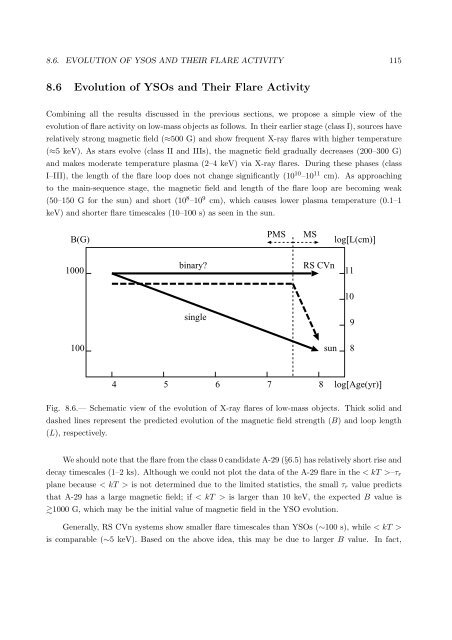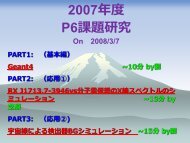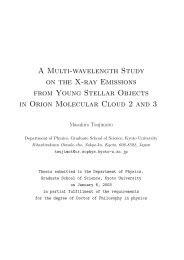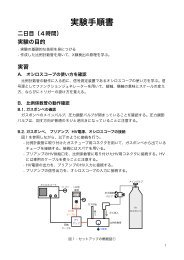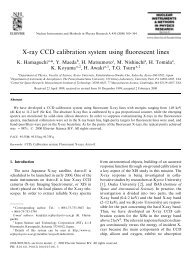X-ray Study of Low-mass Young Stellar Objects in the ρ Ophiuchi ...
X-ray Study of Low-mass Young Stellar Objects in the ρ Ophiuchi ...
X-ray Study of Low-mass Young Stellar Objects in the ρ Ophiuchi ...
You also want an ePaper? Increase the reach of your titles
YUMPU automatically turns print PDFs into web optimized ePapers that Google loves.
8.6. EVOLUTION OF YSOS AND THEIR FLARE ACTIVITY 1158.6 Evolution <strong>of</strong> YSOs and Their Flare ActivityComb<strong>in</strong><strong>in</strong>g all <strong>the</strong> results discussed <strong>in</strong> <strong>the</strong> previous sections, we propose a simple view <strong>of</strong> <strong>the</strong>evolution <strong>of</strong> flare activity on low-<strong>mass</strong> objects as follows. In <strong>the</strong>ir earlier stage (class I), sources haverelatively strong magnetic field (≈500 G) and show frequent X-<strong>ray</strong> flares with higher temperature(≈5 keV). As stars evolve (class II and IIIs), <strong>the</strong> magnetic field gradually decreases (200–300 G)and makes moderate temperature plasma (2–4 keV) via X-<strong>ray</strong> flares. Dur<strong>in</strong>g <strong>the</strong>se phases (classI–III), <strong>the</strong> length <strong>of</strong> <strong>the</strong> flare loop does not change significantly (10 10 –10 11 cm). As approach<strong>in</strong>gto <strong>the</strong> ma<strong>in</strong>-sequence stage, <strong>the</strong> magnetic field and length <strong>of</strong> <strong>the</strong> flare loop are becom<strong>in</strong>g weak(50–150 G for <strong>the</strong> sun) and short (10 8 –10 9 cm), which causes lower plasma temperature (0.1–1keV) and shorter flare timescales (10–100 s) as seen <strong>in</strong> <strong>the</strong> sun.B(G)PMSMSlog[L(cm)]1000b<strong>in</strong>ary?RS CVn1110s<strong>in</strong>gle9100sun84 5 6 7 8log[Age(yr)]Fig. 8.6.— Schematic view <strong>of</strong> <strong>the</strong> evolution <strong>of</strong> X-<strong>ray</strong> flares <strong>of</strong> low-<strong>mass</strong> objects. Thick solid anddashed l<strong>in</strong>es represent <strong>the</strong> predicted evolution <strong>of</strong> <strong>the</strong> magnetic field strength (B) and loop length(L), respectively.We should note that <strong>the</strong> flare from <strong>the</strong> class 0 candidate A-29 (§6.5) has relatively short rise anddecay timescales (1–2 ks). Although we could not plot <strong>the</strong> data <strong>of</strong> <strong>the</strong> A-29 flare <strong>in</strong> <strong>the</strong> < kT >–τ rplane because < kT > is not determ<strong>in</strong>ed due to <strong>the</strong> limited statistics, <strong>the</strong> small τ r value predictsthat A-29 has a large magnetic field; if < kT > is larger than 10 keV, <strong>the</strong> expected B value is1000 G, which may be <strong>the</strong> <strong>in</strong>itial value <strong>of</strong> magnetic field <strong>in</strong> <strong>the</strong> YSO evolution.Generally, RS CVn systems show smaller flare timescales than YSOs (∼100 s), while < kT >is comparable (∼5 keV). Based on <strong>the</strong> above idea, this may be due to larger B value. In fact,


